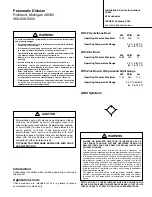
6/30/2016
SE-HP, Manual
Copyright 2016 Vestil Manufacturing Corp. Page 10 of 11
Problem
Possible Causes
Action
Unit will not
raise and motor
runs
Lower solenoid
stuck
No hydraulic
fluid
Is the lowering switch stuck on? If yes, then remove the tiller head via 3
screws on the bottom and replace switch or tap the switch to see if it
unfreezes.
Unit will not
lower
Loose wire
Bad coil
Upper limit
switch out of
adjustment
Verify 24 volts at the coil when the lowering button is depressed. If the
voltage is 0 volts, then trace wiring back to the tiller head looking for
voltage on each side of the connectors until the short or open is found.
If voltage is present and the unit does not lower, remove the connector to
the coil and measure the coil resistance. It should be around 39 ohms.
Replace as necessary.
Loosen the hydraulic line at the pump to relieve the pressure. Adjust the
limit switch so the unit stops at 7 to 8 inches above the floor.
Look for binding in chain or rollers.
Blowing fuses
while rising
Shorted solenoid for
motor raise
Remove the wire to the solenoid coil on the pump motor. Measure the
resistance. It should be around 19 ohms. Replace as necessary.
Maximum lifting
height is not
achieved
Hydraulic oil level is
too low
Fill the hydraulic oil when forks are lowered.
Unit jerks when
lifting
Air in the system
Open the vent screw on the lift cylinder with forks completely lowered. Lift the
forks with vent screw open until oil is free of air bubbles. Tighten vent screw.
Forks raise then
drift downward
Check valve or
solenoid valve
leakage
Lowering vent
leakage
Remove and Inspect
Remove any load from the forks.
Remove the nut holding the solenoid coil on the valve stem and then
unscrew the valve from the manifold.
Inspect the valve for contaminants and inspect
the valve’s O-rings and
back-up washers for cuts, tears and other damage.
With the valve immersed in mineral spirits or kerosene, use a thin tool;
such as, a small screwdriver or small hex wrench, to push the poppet in
and out several times from the bottom end of the valve. The valve
should move freely, about
1
16
⁄
“ from closed to open position. If it sticks
in, the valve stem could be bent and will need to be replaced. If it
doesn’t free up after cleaning, blow the valve off with compressed air
while again pushing the poppet in and out.
Dirt or Debris in the Cylinder
Inspect the valve for contaminants and inspect
the valve’s O-rings and
any back-up washers for cuts, tears or other damage.
Batteries are not
charging
Blown fuse
Dead battery
Verify the fuse is good with an ohm meter.
If the fuse is good, check the charged battery’s voltage. A fully charged
battery should be between 12.6 and 13.0 volts.





























